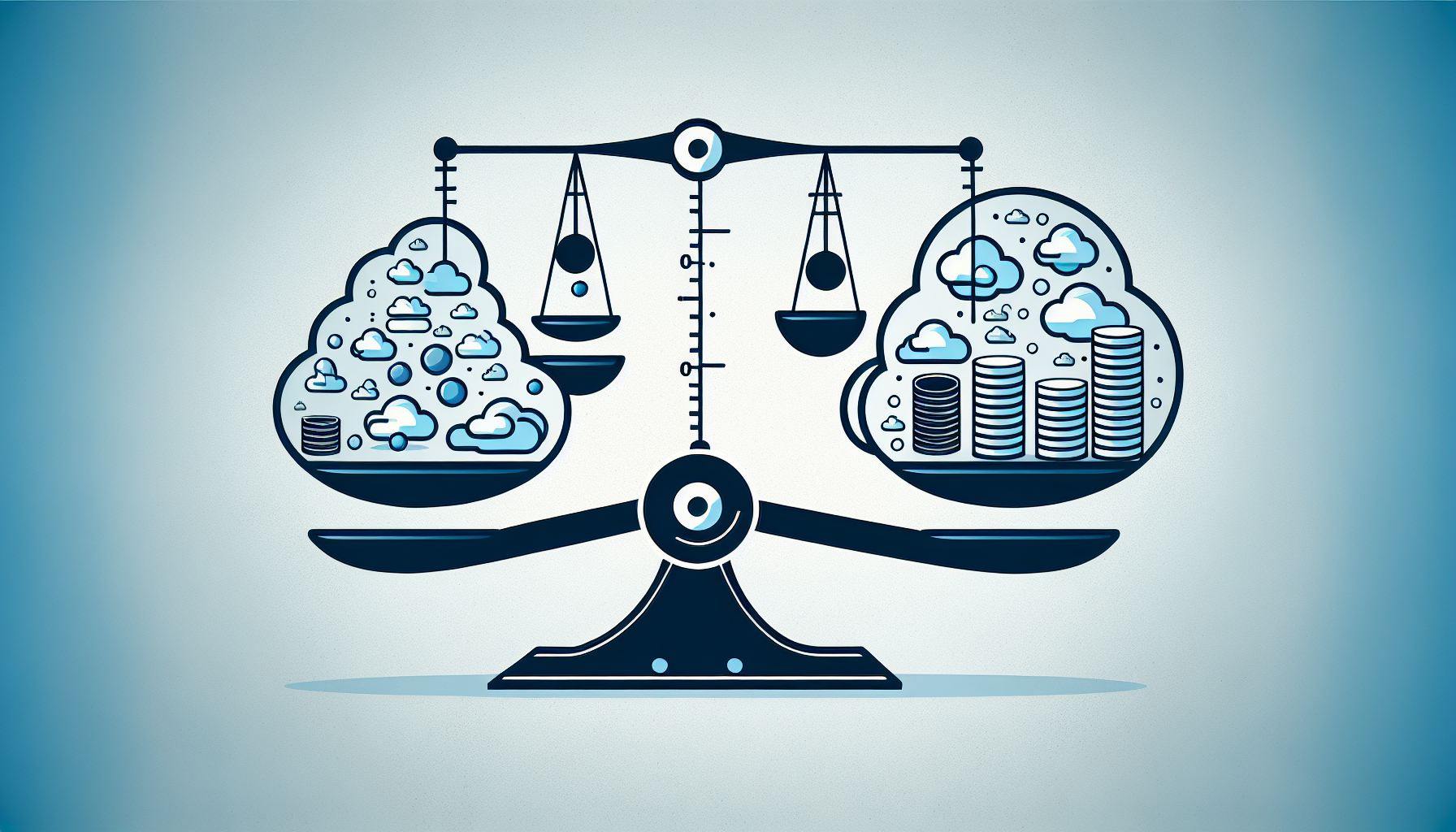The article entitled “Understanding Horizontal Vs. Vertical Scaling: AWS Essentials” provides comprehensive insights into the concepts of horizontal and vertical scaling within the context of Amazon Web Services (AWS). Through depth and practicality, the article ensures a thorough understanding of the subject matter, offering real-world applications and examples. Scenario-based learning allows readers to apply their problem-solving skills to architecting complex solutions on AWS. By utilizing interactive and engaging content, the article incorporates multimedia resources and practical exercises to reinforce learning. Furthermore, the article focuses on preparing readers for the AWS Certified Solutions Architect – Professional exam, aligning with the exam blueprint and providing practice exams and quizzes for self-evaluation. Overall, this article serves as a valuable resource for individuals seeking to enhance their knowledge and proficiency in AWS scaling techniques.
Horizontal Scaling
Definition
Horizontal scaling, also known as scaling out, refers to the practice of adding more servers or machines to distribute the workload and increase capacity. In horizontal scaling, multiple smaller resources work together to handle the load, improving performance and allowing for seamless expansion as the demands grow.
Advantages
Horizontal scaling offers several advantages. Firstly, it provides increased scalability, allowing organizations to handle higher levels of traffic and accommodate growing user bases. Additionally, horizontal scaling is more cost-effective than vertical scaling as it involves adding smaller, less expensive machines instead of investing in more powerful hardware. It also improves fault tolerance and reduces the risk of a single point of failure, as any machine can temporarily go offline without affecting the overall system functionality.
Disadvantages
While horizontal scaling offers numerous benefits, it also has some drawbacks. One of the main challenges is the need for a distributed architecture to effectively handle the workload distribution. This can increase complexity and require additional design considerations. Additionally, not all applications are easily scalable horizontally. Some applications may have dependencies or require shared resources that make it difficult to scale out without re-architecting the entire system.
Vertical Scaling
Definition
Vertical scaling, also known as scaling up, involves increasing the capacity of a single server or machine by adding more resources to it. This can include upgrading the processor, adding more RAM, or expanding storage capacity. Vertical scaling aims to enhance the performance and capacity of an existing system without changing its architecture.
Advantages
Vertical scaling offers several advantages. Firstly, it is simpler to implement since it does not require the design changes associated with horizontal scaling. It also allows for better resource utilization, as a single machine can handle a larger workload. Furthermore, vertical scaling is suitable for applications that have dependencies or require shared resources, as it focuses on enhancing the capacity of a single instance.
Disadvantages
Despite its advantages, vertical scaling also has its limitations. The scalability of vertically scaled systems is often limited by the maximum capacity of the hardware being used. As a result, there is a finite point where further vertical scaling is not possible without significant hardware upgrades or replacing the entire system. Additionally, vertical scaling can be costlier, as it involves investing in more powerful and expensive hardware.

Comparing Horizontal and Vertical Scaling
Scalability
Horizontal scaling offers superior scalability compared to vertical scaling. With horizontal scaling, additional machines can be added to handle the increased workload, allowing for seamless expansion as demands grow. In contrast, vertical scaling has limitations depending on the maximum capacity of the hardware, making it more challenging to scale beyond a certain point.
Cost
Horizontal scaling is generally more cost-effective than vertical scaling. It involves adding smaller, less expensive machines to handle the workload instead of investing in more powerful and expensive hardware. Vertical scaling, on the other hand, requires upgrading or replacing hardware, which can be a significant expense.
Complexity
Horizontal scaling can introduce complexity due to the need for a distributed architecture and handling workload distribution across multiple resources. It requires careful consideration of communication between the machines and effective load balancing to ensure optimal performance. Vertical scaling is generally simpler to implement as it focuses on enhancing the capacity of a single machine without extensive design changes.
Resilience
Horizontal scaling improves the resilience and fault tolerance of a system as it distributes the workload across multiple machines. If one machine fails, the others can continue handling the load, reducing the risk of a single point of failure. Vertical scaling does not offer the same level of fault tolerance, as the entire system relies on a single machine. If that machine fails, the entire system may go offline.
Factors to Consider When Choosing Between Horizontal and Vertical Scaling
Workload Type
The type of workload an application or system needs to handle is an essential factor in choosing between horizontal and vertical scaling. Applications with shared resources or dependencies may require vertical scaling, while those that can be effectively distributed across multiple machines are suitable for horizontal scaling.
Resource Utilization
Consider the existing resource utilization of the system or application. If the current system is underutilized, vertical scaling can be a viable option to make better use of the available resources. However, if resource utilization is already high, horizontal scaling may be necessary to accommodate increased demands.
Future Growth
Consider the expected future growth of the system or application. If there are clear indications of rapid growth, horizontal scaling becomes more beneficial as it allows for seamless expansion with the addition of more machines. Vertical scaling may be suitable when future growth is projected to be moderate and can be accommodated through singular hardware upgrades.
Budget Constraints
Budget constraints play a crucial role in the scaling decision. Horizontal scaling is generally more cost-effective, as it involves adding smaller, less expensive machines. Vertical scaling requires investing in more powerful and expensive hardware, which can strain the budget. Consider the available budget and compare it with the requirements of the application or system.

Best Practices for Horizontal Scaling
Distributed Architecture
To effectively implement horizontal scaling, it is crucial to design a distributed architecture that can distribute the workload across multiple machines. This architecture should support seamless communication and load balancing between the machines.
Load Balancing
Load balancing is a critical aspect of horizontal scaling. Implement load balancers to evenly distribute the incoming requests across the available machines. This ensures that no single machine becomes overloaded while others remain underutilized.
Auto Scaling
Utilize auto scaling mechanisms to automatically add or remove machines based on the workload demands. This allows for dynamic scaling and helps ensure optimal performance and resource allocation. Configure proper scaling policies and thresholds to effectively utilize the available resources.
Best Practices for Vertical Scaling
Vertical Architecture
When vertically scaling a system, it is crucial to consider the limitations of the existing hardware and choose appropriate upgrades or replacements. Design the architecture in a way that allows for easy incorporation of the additional resources.
Performance Optimization
Optimize the performance of the system by properly configuring the upgraded resources such as processors, RAM, and storage. Consider the specific requirements of the application or system and fine-tune the settings accordingly to ensure optimal performance.
Upgrading Hardware
When vertically scaling, carefully select the hardware upgrades based on the specific needs of the system. Upgrade the processors, RAM, or storage capacity to meet the increasing demands and enhance the overall performance of the system.

Case Studies: Horizontal Scaling in AWS
Netflix
Netflix utilizes horizontal scaling in AWS to handle its massive user base and streaming demands. By distributing its workload across numerous servers, it can seamlessly accommodate increased traffic. Netflix employs a distributed architecture with load balancers to ensure efficient workload distribution and fault tolerance.
Amazon.com
Amazon.com, being one of the world’s largest e-commerce platforms, leverages horizontal scaling to handle the high volume of user requests. By distributing the workload across multiple machines, Amazon.com ensures optimal performance and scalability during peak shopping seasons. Load balancers play a crucial role in evenly distributing requests across the available resources.
Airbnb
Airbnb, an online marketplace for lodging and experiences, implements horizontal scaling in AWS to handle its global user base and variable demand. By employing a distributed architecture with load balancers, Airbnb can seamlessly scale its infrastructure to accommodate fluctuations in demand, ensuring a smooth booking experience for its users.
Case Studies: Vertical Scaling in AWS
Instagram uses vertical scaling in AWS to enhance the performance and capacity of its infrastructure. By upgrading the hardware resources, such as processors and RAM, Instagram is able to handle the increasing demands of its growing user base. This approach allows them to efficiently utilize the existing resources without major architectural changes.
Twitter employs vertical scaling in AWS to improve the overall performance and capacity of its platform. By upgrading the hardware resources of its servers, Twitter can handle the high volume of tweets and user engagement. Vertical scaling enables Twitter to enhance its system performance without changing its existing architecture.
Snapchat
Snapchat relies on vertical scaling in AWS to scale its infrastructure as its user base and demands grow. By upgrading the hardware resources, such as processors and storage, Snapchat can effectively handle the immense amount of images and videos shared on the platform. Vertical scaling allows Snapchat to enhance its capacity without introducing significant architectural changes.
Hybrid Scaling: Combining Horizontal and Vertical Scaling
Definition
Hybrid scaling refers to the combination of horizontal and vertical scaling approaches to achieve optimal scalability and performance. It involves scaling out by adding more machines and distributing the workload, while also scaling up by upgrading the existing hardware resources to enhance capacity.
Use Cases
Hybrid scaling is particularly useful in scenarios where applications have varying resource requirements. By combining horizontal and vertical scaling, organizations can efficiently utilize the available resources while accommodating both scalability and performance needs. Hybrid scaling is commonly used in large-scale systems and complex architectures where a flexible and dynamic approach to scaling is necessary.
Implementation Considerations
Implementing hybrid scaling requires careful planning and coordination. The system architecture should be designed to support both horizontal and vertical scaling approaches. Load balancers and auto scaling mechanisms should be configured to effectively distribute the workload and add/remove instances based on demand. Additionally, organizations should regularly analyze the system’s resource utilization and performance to determine the most effective scaling approach.
Conclusion
Understanding the differences between horizontal and vertical scaling is crucial for organizations seeking to improve the scalability and performance of their applications or systems in AWS. Horizontal scaling offers increased scalability, cost-effectiveness, and resilience, while vertical scaling provides simplicity and enhanced resource utilization. Factors such as workload type, resource utilization, future growth, and budget constraints must be carefully considered when choosing between the two approaches. Best practices for each scaling method, as well as real-world case studies, showcase the effectiveness of horizontal and vertical scaling in AWS. Additionally, the concept of hybrid scaling offers a flexible and dynamic approach to achieve optimal scalability and performance. By following these guidelines and understanding the specific requirements of their applications, organizations can make informed decisions and implement the most appropriate scaling approach in AWS.

